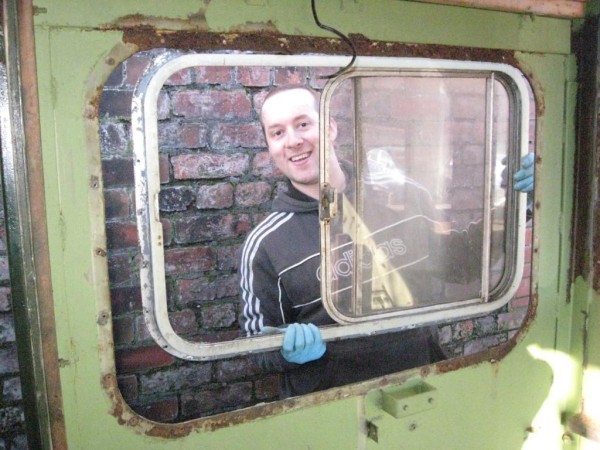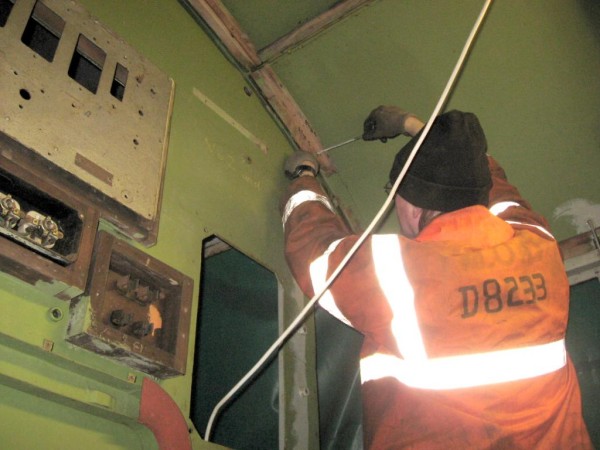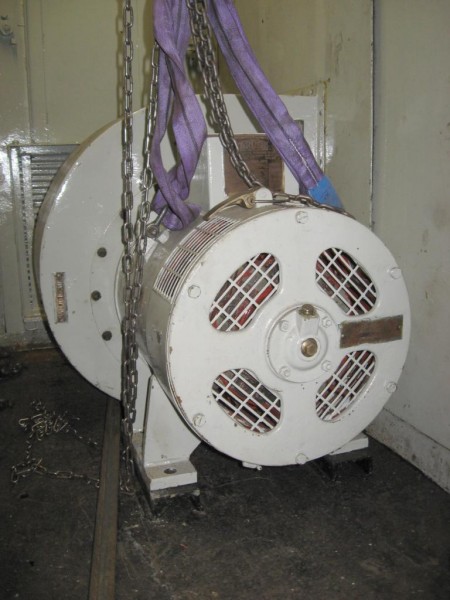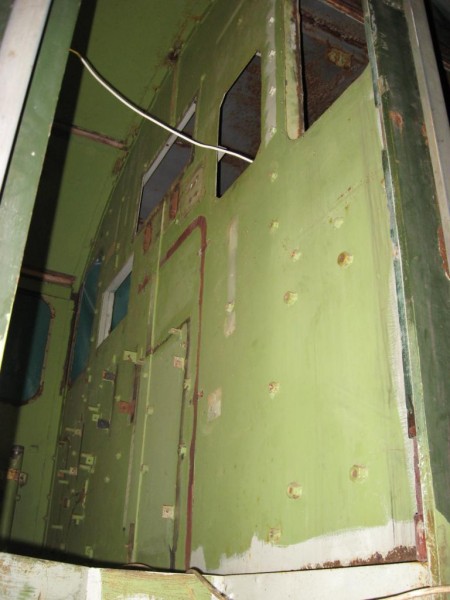30-31 January 2010
Saturday 30 th January Attendance: 3 With no work being done to D8233 during its last working weekend on 16 th & 17 th there was a need to try and catch up but in the days leading up to this weekend an appraisal of job priorities on D8233 by our Project Leader had shown a need to concentrate on the task of making the Cab & ‘B' end body sections on D8233 ready for lifting off as it is planned to send them away for shot blasting at a local firm in March, but in addition to our other tasks it had also been decided that some work on Class 14 D9531 should be attempted as the loco is now in Baron St loco works visible progress needs to be made otherwise the loco will be shunted out, so as well as D5705 & D8233 the volunteers were asked if they could spend Saturday afternoon working on D9531 and tackle the task of fitting up the Fuel & coolant pipe work to the replacement power unit. But before all that could be done the tarp over the Cab & ‘B' end of D8233 had to be pulled back so that a man from the shot blasting firm could come down first thing in the morning to inspect the cab get an estimation for the job. The guy from the firm arrived bang on time at 09:30 and spent the next 15 mins being shown the size of the pieces requiring shot blasting, there was a concern by us that D8233's Cab would be too big for them to handle but the guy nonchalantly said that their shot blasting booth was 60ft long and after he'd seen the size of the loco while it was covered by the tarp he through that we wanted the whole loco doing, anyway he seemed confident that the job could be done and at a reasonable price so he departed, however while the tarp was off the cab of the 15 it was decided to remove the remaining cab windows as the needed to be stripped off and it would be difficult with the trap over the loco. Adam & Jason got to work, first removing the L/H side window, the windows are help on by screws that pass through holes in the window aperture in the body side and screw into the batten frame on the inside, most of the screws came out OK but some needed the impact driver to get them moving. Jason finished off the L/H side window while Adam tacked the R/H side, after all the screws were removed it was quite difficult to push the frames out as there was a thin seal of a sticky putty like substance around the edge of the frame, eventually the L/H windows was removed and then shortly after the R/H frame came out too, then it was just the B end bulkhead windows to go (The A end windows were removed a long time ago) Jason tackled one side and Adam the other and soon all the glass was out and the tarp could now be pulled back over the cab & B end and re-secured and Adam & Jason could get on with the other jobs they had planned. The rest of the morning saw Jason, Adam and Chris Tatton (who had just arrived ) go down to the Co-bo tent to do some reinforcement work in there that took them up to lunch time, the afternoon was spent working on D9531 and no further work was done to the class 15. Sunday 31 st January Attendance: 2 Sunday morning began with Jason looking over D9531 and then going for breakfast after which they went up to Castlecroft to look for some parts for the 14 with Adam, however they were unable to find any of the specific parts they had been searching for and returned to Baron St where they went to work on the other locos, Adam was working in the Co-bo and Jason the 15. In D8233 Jason made ready his task of stripping out the remaining fittings and batons inside the cab, although mostly stripped already there are still a few residual bits here and there that will still need to be removed these are mostly batons on the side walls, ceiling and front & rear bulkheads, there is also some left over conduits and remains of a couple of control panels, the windows and associated inner baton frames had been removed had been taken out the day before so that was one less thing to worry about but as for the rest Jason had is work cut out for him. He decided to start with the B end cab bulkhead this has the most original parts still attached, but first before anything could be removed he had to mark up all the bits and take reference photos of them for later on when time comes to rebuild, so he took time to mark up all the battens on B bulkhead using the code B2# plus the number, starting in the L/H rear upper corner and working his way across things went quite easy until he reached the middle when he realised that the batons were attached by screws driven in from the opposite side of the bulkhead and could not be removed from inside the cab. During the Day Jason went down to have a look in the A end nose compartment, as sitting in there is one of the fully overhauled traction motor blowers, this had been restored by Project Leader Chris Baily in his garage workshop back at home with help from other group members. The Ex-Class 31 TMB are now ready for refitting, the one in the B end will have to wait for now but the A end one is now sitting in its place, this had been brought back on December 18 th by Rob and Jim and hoisted up into the nose end. The TMB has only been placed for now as the bolts onto the custom floor brackets have yet to be fitted. But there is still the ducting modifications to be made to the bulkhead and TMB duct in the cooler group so it will be a while before its fully fitted, but at least its yet another fully restored auxiliary machine back in the loco. The next task would be rather unpleasant, it involved crawling into the electrical cubical compartment which is full of dust & rust and using a drelling grinder clean off the paint from all the heads of the screws that pass through the bulkhead and into the batoning on the other side, and the screws were many. After this had been done Jason had to use an impact driver to start the screws turning before he could draw them out using a regular screwdriver, this was quite time consuming but as the job progressed he was able to go into the cab and remove the batons bit by bit. In the centre of the bulkhead are the baton frame for the fuse board and just below it is a switch panel and a separate fuse box, these are not original fittings and modifications made during the ETH unit conversion in 1969, this became obvious when they were removed as both show signs of being fitted as an afterthought and not part of the original design. With all the top end batons removed it was time to move down below, the metal conduit that runs from the main electrical duct up the bulkhead and around to a channel under the main fuse board panel was taken down, but getting to the baton screws was not going to be so easy, the main reason being that the cab bulkhead in the lower compressor compartment of B end has things bolted onto the bulkhead, BIG things, like the Timing air tank for the electrical cubical, getting this off was going to be a mission. First Jason had to undo the tarp around the other side of the B end so he could get access to the area the other side, he had to get a number of large sockets and spanners, then he undone the ¾ whitworth bolts from the air tank brackets all while crouching in the confined space of the compartment. After doing the bolts on the L/H side he noticed the frame bolts connecting the B end frame to the cab bulkhead and while in the area he used the socket and power bar to crack them off and then the ratchet to undo them, some bolt heads were seized and sheared off others with inaccessible while the door frame seal were still in place, these had to be chiselled off to get access to the bolts, with most of the bolts out Jason moved over to the other side of the compartment. On the other side there is a lot more space to move around in but still a lot of fitting to take off the bulkhead, as well as the air tank there is a large manifold with a number of air valves attached to it, this is connected to the air tank and a pipe feed that passes through the floor as well as a air pressure gauge. The glass in the gauge was cracked long ago so this was the first thing to be removed, disconnecting the pipes was difficult as they have not been touched in decades and are quite rusty but eventually some of the pipes came off and the valve manifold could be removed. This granted access to the two remaining bolts on the air tank so this was soon whipped off also. There were a few screw heads here that needed cleaning off and taking out and that allowed the removal of the remaining batons on the other side of the cab bulkhead, with that done it was time to start packing up. Jason had used many different tools during the day and it took quite a few trips back to support coach to put them all away. he cab windows which had been stowed here overnight were also removed and taken to the support coach for safe keeping, then the large baton window frames were placed in the cubical compartment for now and the rest of the batons that had been removed will stay on the floor for now, with everything away Jason tied up the tarp on the loco and returned to the support coach where he gave Adam a hand with a few minor Co-bo tasks that he was finishing up. The last scheduled D8233 working weekend being a non-event the work done this weekend was enough to make up for it, but with the need now to get the cab & B end ready for lifting off it gives us a specific task to focus on for the next working weekend. The next working weekend is 13/14 February. If you wish to lend a hand please contact Chris Tatton |
 |
| Above : Early Saturday morning and the windows are being removed from the cab. © C15PS |
 |
| Above : Adam poses with the R/H cabside window having just removed it. © C15PS |
 |
| Above : Jason begins the task of removing the baton from the rear cab bulkhead. © C15PS |
 |
Above : One of the restored TMB's has been put back in the Nose end compartment.© C15PS |
 |
Above :
The rear Cab bulkhead is now fully stripped of all bits ready for shot blasting.
© C15PS |
 |
Above :
All the batons that were removed from the bulkhead are seen here.
© C15PS |
Fancy Getting Involved? click on the You Can Help page